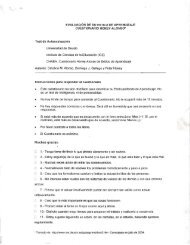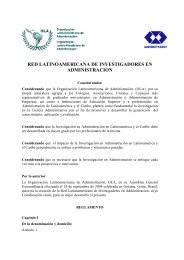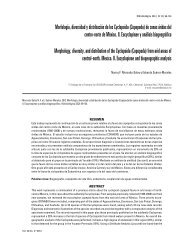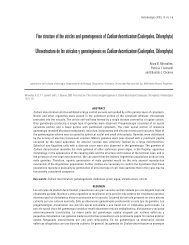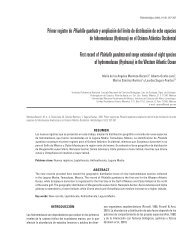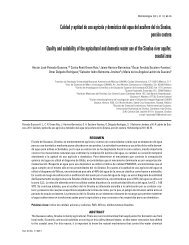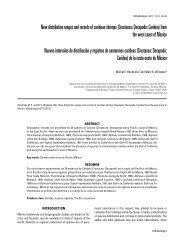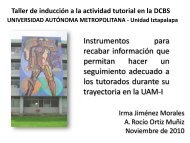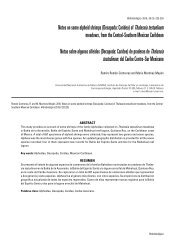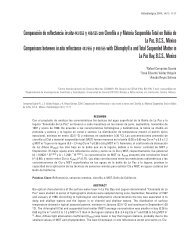Phase change of light reflected by a discontinuity in the derivatives ...
Phase change of light reflected by a discontinuity in the derivatives ...
Phase change of light reflected by a discontinuity in the derivatives ...
You also want an ePaper? Increase the reach of your titles
YUMPU automatically turns print PDFs into web optimized ePapers that Google loves.
R. Diamant, M. Fernández-Guasti / Optics Communications 294 (2013) 64–72 65where k 2 0 ¼ po2 m 0 E 0 and <strong>the</strong> refractive <strong>in</strong>dex is n ¼ E=E ffiffiffiffiffiffiffiffiffi0,E0 is <strong>the</strong> To model a s<strong>in</strong>gle <strong>in</strong>terface, n(z) must be a monotonic cont<strong>in</strong>uousA 2 d ¼ 1 The parameter D is a measure <strong>of</strong> <strong>the</strong> <strong>in</strong>terface thickness, correspond<strong>in</strong>g to 90% <strong>of</strong>n : ð12Þ <strong>the</strong> <strong>in</strong>dex <strong>change</strong>. The overall refractive <strong>in</strong>dex <strong>change</strong> is labeled Dn and <strong>the</strong> halfvalue<strong>by</strong> n avg. The figure shows a pr<strong>of</strong>ile with D ¼ 2l.electric permittivity <strong>of</strong> vacuum. Now, consider a complex E x ,namely E x ¼ Ae iq , where <strong>the</strong> amplitude A and phase q depend onz. We restrict <strong>the</strong> problem to non absorb<strong>in</strong>g media, so we willassume <strong>the</strong> refractive <strong>in</strong>dex to be a real quantity. Substitution <strong>in</strong>function evolv<strong>in</strong>g from n i to n t . Far from <strong>the</strong> <strong>in</strong>terface n should bealmost constant. To evaluate <strong>the</strong> reflectivity, <strong>the</strong> convenient <strong>in</strong>itialcondition is a s<strong>in</strong>gle transmitted wave through <strong>the</strong> second medium,so <strong>the</strong> <strong>in</strong>cident <strong>light</strong> is assumed to come only from <strong>the</strong> first mediumEq. (3) and separation <strong>of</strong> real and imag<strong>in</strong>ary parts render:side. This implies that <strong>the</strong> solution <strong>in</strong> <strong>the</strong>psecond medium, far fromd 2 AA dq 2<strong>the</strong> <strong>in</strong>terface, is almost constant A d ¼ffiffiffiffiffiffiffiffiffiffi1=n t.Under this condition,¼ k 2dz 20dzA, ð4Þ <strong>the</strong> amplitude oscillations <strong>in</strong> <strong>the</strong> first medium, far from <strong>the</strong> <strong>in</strong>terface,will exhibit <strong>the</strong> medium’s reflectivity: R ¼ r 2 . Given <strong>the</strong> <strong>in</strong>dices n i2 dA and n t , we expect <strong>the</strong> reflectivity to depend on <strong>the</strong> <strong>in</strong>terfacedqþA d2 qdz dz dz ¼ 0:ð5Þ abruptness. This property can be characterized <strong>by</strong> <strong>the</strong> distance D2 through which <strong>the</strong> <strong>in</strong>dex varies from n i þð1=20ÞDn to n t ð1=20ÞDn,Eq. (5) can be readily <strong>in</strong>tegrated to obta<strong>in</strong> an <strong>in</strong>variant quantitygiven <strong>by</strong>so that parameter D can be thought as <strong>the</strong> <strong>in</strong>terface thickness,correspond<strong>in</strong>g to 90% <strong>of</strong> <strong>the</strong> <strong>in</strong>dex <strong>change</strong> as shown <strong>in</strong> Fig. 1.In an earlier paper [13] studies <strong>of</strong> <strong>the</strong> <strong>in</strong>terface reflectivity,Q ¼ A 2 dqdz :ð6Þ given different pr<strong>of</strong>iles with vary<strong>in</strong>g thicknesses, have been done.All pr<strong>of</strong>iles were cont<strong>in</strong>uous, but some were piecewise def<strong>in</strong>edA nonl<strong>in</strong>ear ord<strong>in</strong>ary differential equation for <strong>the</strong> amplitude isobta<strong>in</strong>ed upon substitution <strong>of</strong> this result <strong>in</strong> Eq. (4)and <strong>the</strong>ir <strong>derivatives</strong> were discont<strong>in</strong>uous. For ‘‘hard’’ <strong>in</strong>terfaces,mean<strong>in</strong>g D l=100, reflectivity was close to <strong>the</strong> Fresnel resultd 2 A Q 2dz 2 A ¼ 3 k2 0 n2 A: ð7Þ R ¼ n t n 2i,n t þn iThis is an Ermakov–Milne–P<strong>in</strong>ney type equation. In order to work regardless <strong>of</strong> <strong>the</strong> pr<strong>of</strong>ile type. For ‘‘s<strong>of</strong>ter’’ <strong>in</strong>terfaces, D l=2, <strong>the</strong>withpa dimensionless amplitude function let us <strong>in</strong>troduceA d ¼ Affiffiffiffiffiffiffiffiffiffiffireflectivity <strong>of</strong> almost all n(z) pr<strong>of</strong>iles fell to less than 6% <strong>of</strong> <strong>the</strong> Fresnelk 0 =Q, <strong>the</strong>n Eq. (7) can be rewrittenresult. The reflectivity for <strong>the</strong> analytic pr<strong>of</strong>iles dropped monotonicallyd 2 1for D4l. In contrast, for <strong>the</strong> piecewise def<strong>in</strong>ed pr<strong>of</strong>iles, <strong>the</strong> reflectivityoscillates as a function <strong>of</strong> thickness. Every piecewise def<strong>in</strong>edA d¼ n 2 Ak 2 0 dz2 A 3 d : ð8Þdpr<strong>of</strong>ile had two attachment planes, at z 1 and z 2 , <strong>in</strong> order to keep <strong>the</strong>This is <strong>the</strong> ord<strong>in</strong>ary differential equation for <strong>the</strong> electric fieldamplitude. It is not common to turn a l<strong>in</strong>ear differential equation<strong>in</strong>terface symmetry and a bounded refractive <strong>in</strong>dex. The reflectivityoscillations <strong>in</strong> <strong>the</strong>se cases were <strong>in</strong> accordance with th<strong>in</strong> film <strong>in</strong>terference,<strong>in</strong>to a nonl<strong>in</strong>ear ODE, but Eq. (8) poses no challenge to be solvedwith a film thickness <strong>of</strong> z 2 z 1 . Evidently discont<strong>in</strong>uities <strong>in</strong>numerically if A d is real and n is bounded. Also, <strong>in</strong>itial conditionsare easily imposed hav<strong>in</strong>g a clear physical mean<strong>in</strong>g and f<strong>in</strong>ally,<strong>in</strong>terpretation <strong>of</strong> <strong>the</strong> solutions is straightforward. The f<strong>in</strong>itedifference method for numerically solv<strong>in</strong>g ord<strong>in</strong>ary differentialequations is used, with s<strong>in</strong>gle precision float<strong>in</strong>g po<strong>in</strong>t numbers.<strong>the</strong> pr<strong>of</strong>ile <strong>derivatives</strong> were caus<strong>in</strong>g reflections. However, it was notclear, only from <strong>the</strong> <strong>in</strong>terference data, which type <strong>of</strong> phase <strong>change</strong>was <strong>the</strong> <strong>reflected</strong> wave undergo<strong>in</strong>g at <strong>the</strong> z 1 and z 2 boundaries. Wecould only <strong>in</strong>fer <strong>the</strong> relative phase between <strong>the</strong> two reflections. Ourtask now is to evaluate <strong>the</strong> phase <strong>change</strong> upon reflection, based on<strong>the</strong> <strong>in</strong>terpretation <strong>of</strong> <strong>the</strong> amplitude equation numerical solutions.1.2. Interpretation <strong>of</strong> <strong>the</strong> solutionsA good example <strong>of</strong> how <strong>the</strong> junctions <strong>of</strong> a cont<strong>in</strong>uous butpiecewise n(z) function still generate reflection, even when <strong>the</strong><strong>in</strong>terface is gradual, is shown <strong>in</strong> Fig. 2. The bottom graph displaysA constant n represents a homogeneous medium, <strong>in</strong> this casereflectivity R versus <strong>in</strong>terface thickness D, <strong>in</strong> wavelength units, for<strong>the</strong> solutions <strong>of</strong> Eq. (8) are known and must be <strong>of</strong> <strong>the</strong> formtwo n(z) pr<strong>of</strong>ile types. Both pr<strong>of</strong>iles are cont<strong>in</strong>uous but one <strong>of</strong>[12–14,20]:<strong>the</strong>m, labeled as ‘‘tanh’’, is analytic and <strong>the</strong> o<strong>the</strong>r, ‘‘l<strong>in</strong>ear’’, isqffiffiffiffiffiffiffiffiffiffiffiffiffiffiffiffiffiffiffiffiffiffiffiffiffiffiffiffiffiffiffiffiffiffiffiffiffiffiffiffiffiffiffiffiffiffiffiffiffiffiffiffiffiffiffiffiffiffiffiffiffiffiffiffiA d ¼ A 2 1 þA2 2 þ2A 1A 2 cosð2k 0 nzþdÞ: ð9ÞThe field amplitude A d is produced <strong>by</strong> <strong>the</strong> superposition <strong>of</strong> twocounter propagat<strong>in</strong>g waves, with <strong>in</strong>dividual constant amplitudesA 1 and A 2 . The constant d is <strong>the</strong> phase difference between bothwaves at z¼0. There is a restriction for <strong>the</strong>se amplitudes if Eq. (8)is to be satisfied:ðA 2 1 A 2 2 Þ2 ¼ 1 n : 2 ð10ÞThis homogeneous medium solution A d (z) oscillates periodically ifboth, A 1 and A 2 , are nonzero. Maxima A max and m<strong>in</strong>ima A m<strong>in</strong> occurwhen <strong>the</strong> <strong>in</strong>com<strong>in</strong>g and outgo<strong>in</strong>g waves are <strong>in</strong> or out <strong>of</strong> phase,respectively. These extrema can also be related to <strong>the</strong> ratior ¼ A 2 =A 1 [12,13]:r ¼ A max A m<strong>in</strong>:A max þA m<strong>in</strong>ð11ÞIf <strong>the</strong>re is only one wave propagat<strong>in</strong>g, A 1 or A 2 is zero and A d isconstant, particularlyFig. 1. To model a s<strong>in</strong>gle <strong>in</strong>terface, n(z) must be a monotonic cont<strong>in</strong>uous functionthat evolves from n i to n t . Far from <strong>the</strong> <strong>in</strong>terface n should be practically constant.



